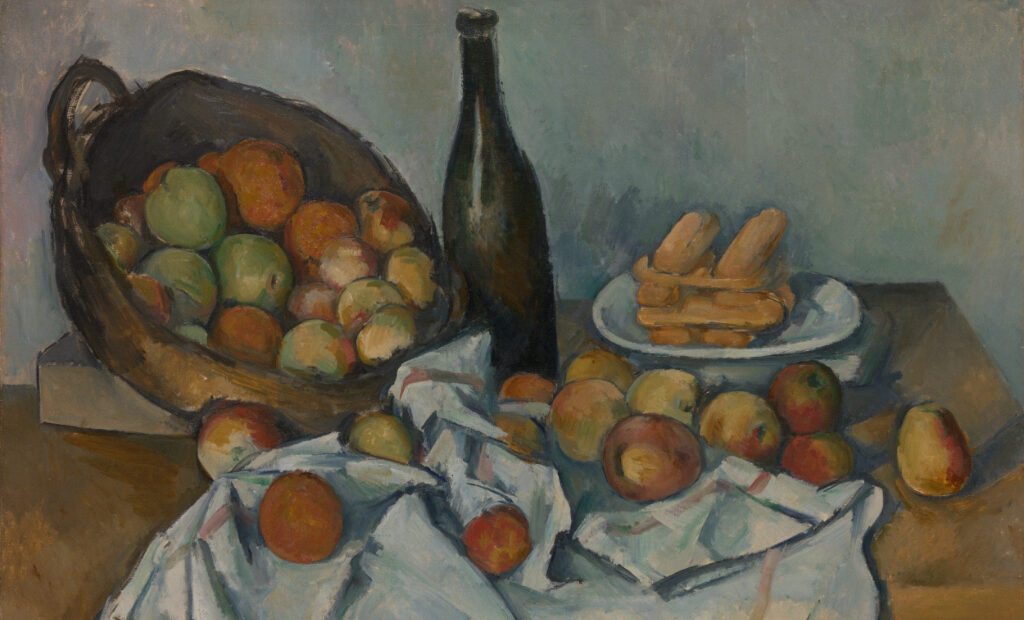Cezanne at Tate Modern

“Cezanne was my one and only master. It was the same for all of us – he was like our father. It was he who protected us. Cezanne’s influence gradually flooded everything.” – Pablo Picasso.
The Cezanne exhibition opening at the Tate Modern on 5th October 2022 is the culmination of five years of work. This carefully curated 11-room show contains 80 of Cezanne’s works created from the start to the end of his career, including 22 paintings, drawings and watercolours never seen in the UK before. Cezanne follows the painter’s artistic development and his maturing style.
Paul Cézanne was a post-impressionist French artist who is credited for laying the foundations that enabled later artists to experiment with new and daring styles. Born in Aix-en-Provence, southern France, in 1839, Cezanne originally trained as a lawyer under his father’s duress, before moving to Paris in 1861. This exhibition explores a broad range of Cezanne’s work, including his obsession with the landscapes of Mont Saint-Victoire and L’estaque, his tender depictions of his wife and child, the iconic bathers and still lifes, and how Cezanne’s later art illustrates the artist coming to terms with his own mortality.
Beginning with a self-portrait, the display traces the artist’s life and how his relationships helped him develop his personal style and start to “become Cezanne”. In the second room, the left wall explores how Cezanne’s relationship with childhood friend Emile Zola (who encouraged him to leave Provence and move to Paris to live an avant-garde life) influenced Cezanne’s darker early works, including The Murder with its bulging culprits painted under a billowing black cloud. On the right, Cezanne explores his influential relationship with fellow painter Camille Pissarro, who encouraged the artist’s more colourful and warm style.
With so many rooms to explore, it can be hard to keep to the intended order, although the wall colour – sombre purple for the end “Slow Homecoming” room, which explores mortality, fading blue and grey for the others – gently contributes to the overall tone of each room’s specific theme. Whilst the exhibition promises to explore more about Cezanne’s relationships and identity, aside from “Becoming Cezanne” and “Family Portraits” (and even in these, the informational focus is much more on the style of the paintings than the relationship between artist and subject), it feels more like a technical love letter to art, style and process.
In room six, “Modern Materials”, Cezanne’s original painting materials, including four watercolour tins and his palette, are displayed. There is an x-ray illustrating Cezanne’s use of very thin lines, so thin that most of them barely show up in the x-ray. There is a sense of reverence in room 10, “The Artist’s Artist”, which includes artists who influenced Cezanne and in turn, the artists who credit Cezanne as a major source of inspiration. Throughout the show, there are written contributions from contemporary artists who explain their thoughts on Cezanne’s work and how it has inspired them.
Cezanne shows the artist’s work coming in an almost full circle from his moody, darkly drawn early works inspired by the seedy underbelly of Paris, through his sometimes warm, sometimes cold, but always colourful and often dreamy collections of still lifes, bathers, mountains and landscapes, to the end room, “1899-1906: Slow Homecoming” which displays his later work, including Les Trois Crânes (1900) (The Three Skulls). This piece seems to suggest that the loss of Cezanne’s mother and his own diagnosis of diabetes and increasingly fragile state had prompted a return to his more gloomy, darkly painted roots.
However, this final room also holds a meditative calm. The Gardener Vallier (1906) depicts a solitary figure sitting cross-legged against a leafy backdrop and deep blue sky. There is a sense of sereneness and acceptance which radiates from this painting. The figure feels content with how life has turned out and emits an aura of wisdom, perhaps an ode to how Cezanne felt as he approached the end of his life.
Cezanne is a large, ambitious and beautifully curated collection of the painter’s work. A must-see for art historians and artists alike, this exhibition also gives the general public a broad and intimate understanding of Cezanne in the context of his time, his changing style and the depth with which you can view his work.
Sophia Moss
Cezanne is at Tate Modern from 5th October until 12th March 2023. For further information visit the exhibition’s website here.
























Facebook
Twitter
Instagram
YouTube
RSS